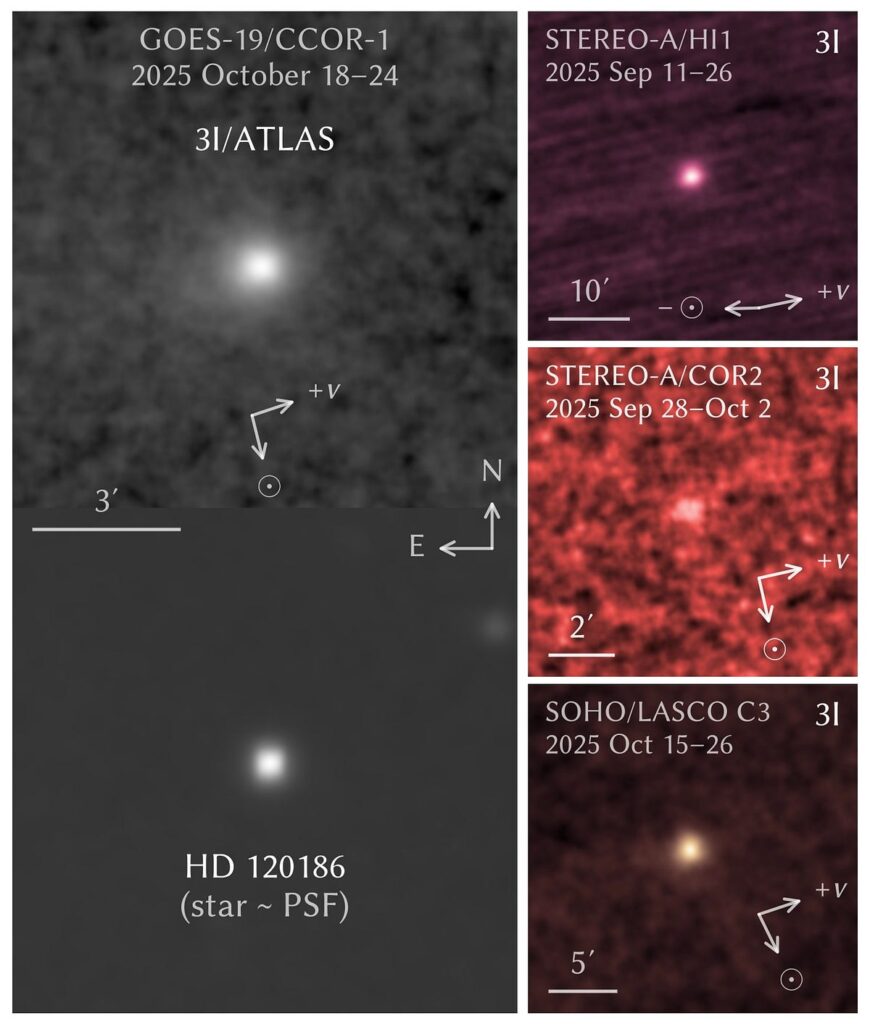New images of the interstellar object 3I/ATLAS as it approached perihelion on October 29, 2025, reveal rapid brightening and a color bluer than the Sun.
3I/ATLAS is currently hidden from terrestrial telescopes behind the Sun, as it went through solar conjunction relative to Earth on October 21, 2025. However, this unfavorable geometry of opposition from Earth — a possible hint of design, placed 3I/ATLAS within the fields of view of several space-based solar coronagraphs and heliospheric imagers, enabling its continued observation during its final approach toward perihelion.
The new observations were taken by the following set of instruments:
1. STEREO (“Solar TErrestrial RElations Observatory”) consists of two identical spacecraft launched in 2006: STEREO-A, which orbits slightly more quickly than Earth around the Sun, and STEREO-B, which orbits slightly more slowly than Earth around the Sun. STEREO-B has not been operational since 2014, so only STEREO-A observed 3I/ATLAS. The observations were made by two cameras, HI1 and COR2, on the SECCHI (“Sun Earth Connection Coronal and Heliospheric Investigation”) instrument suite.
2. SOHO (“SOlar and Heliospheric Observatory”), launched in 1995, orbits the Sun–Earth first Lagrange (L1) point, carrying the LASCO (“Large Angle and Spectrometric COronagraph”) coronagraphs.
3. GOES-19, launched in 2024, is a weather satellite operating in a geostationary orbit, carrying the CCOR-1 (“Compact CORonagraph 1”) coronagraph.
The new paper (accessible here) reports observations of 3I/ATLAS from STEREO-A’s SECCHI HI1 and COR2, SOHO’s LASCO C3, and GOES-19’s CCOR-1 instruments during the months of September and October 2025.
The data shows a rapid rise in the brightness of 3I/ATLAS, scaling inversely with distance from the Sun to the power of -7.5 (±1).
CCOR-1 resolves a glow extending out to 300,000 kilometers around 3I/ATLAS, comparable to the scale of the plume of carbon dioxide, traced by the SPHEREx Space Observatory on August 8–12, 2025 (accessible here).
In addition, 3I/ATLAS appears distinctly bluer than the Sun in LASCO/CCOR-1 color photometry — in contrast to earlier observations showing it to be red — suggesting that emission contributes a substantial fraction of the overall visible brightness.
Following its 2025 October 29 perihelion, 3I/ATLAS will return to be observable from Earth at twilight. As it arrives at closest approach to Earth on December 19, 2025, ground-based observations as well as data from the Hubble and Webb space telescopes during the month of December will be able to characterize 3I/ATLAS in great detail. The new data suggests that 3I/ATLAS will likely emerge from perihelion brighter than before.
The authors of the new paper state: “The reason for 3I/ATLAS’s rapid brightening, which far exceeds the brightening rate of most Oort cloud comets at similar distances from the Sun, remains unclear.”
The appearance of 3I/ATLAS as bluer than the Sun is very surprising. Dust is expected to redden the scattered sunlight, and the surface of the object is expected to be an order of magnitude colder than the 5,800 degrees Kelvin at the photosphere of the Sun, resulting in it having a redder color than the Sun. We must therefore add the blue color at perihelion as a ninth anomaly to the list of unexpected properties (compiled most recently here) of this strange interstellar object. Does it employ a power source that is hotter than the Sun?
ABOUT THE AUTHOR
Avi Loeb is the head of the Galileo Project, founding director of Harvard University’s — Black Hole Initiative, director of the Institute for Theory and Computation at the Harvard-Smithsonian Center for Astrophysics, and the former chair of the astronomy department at Harvard University (2011–2020). He is a former member of the President’s Council of Advisors on Science and Technology and a former chair of the Board on Physics and Astronomy of the National Academies. He is the bestselling author of “Extraterrestrial: The First Sign of Intelligent Life Beyond Earth” and a co-author of the textbook “Life in the Cosmos”, both published in 2021. The paperback edition of his new book, titled “Interstellar”, was published in August 2024.

